As parents, we all want to nourish our babies with the healthiest foods to support their growth and development. If you’ve already begun solid foods, you know that whole foods like fruits, vegetables, grains, and meat are all recommended for your baby.
Fermented foods, on the other hand, don’t typically get put in the category of “best first foods” even though they’re highly nutritious and offer a number of health benefits for your baby!
Fermented foods are rich in probiotics, which can help support your baby’s digestion, boost their immune system, and even introduce them to new, exciting flavors. In this blog, we’ll walk you through the benefits of fermented foods, when and how to introduce them to your little one, and the safest ways to incorporate them into your baby’s diet.
By the end, you’ll feel confident in offering these nutrient-packed foods that promote healthy growth for your little one!
Table of Contents
Can babies eat fermented foods?
Fermented foods are safe for babies from around 6 months, when they’re showing all of the developmental signs of readiness to start solids. We encourage you to introduce fermented foods early on in your baby’s feeding journey because they’re a great way to expose your baby to strong flavors!

At the same time, there are some important things to consider before introducing fermented foods to your baby – let’s take a closer look at which ones are safe.
10 fermented foods that are safe for babies
The list of fermented food products that exist in the world is extremely vast. The process of fermentation – where microorganisms like yeast and bacteria break down food products – results in a wide variety of foods with distinct flavors, textures, and health benefits (1).
The diversity comes from traditional foods found all around the world, cultural preferences, different geographical areas where they are produced, and the staple products and/or by-products used for fermentation.
Since there is so much diversity when it comes to fermented foods, it can be challenging to know which ones are safe for babies to consume. The following list highlights popular fermented foods that can be safely introduced to babies around 6 months of age.
Remember that some fermented foods contain allergens (including wheat, dairy, and soy). When this is the case, they should be introduced cautiously and one at a time, according to the proper introduction protocol.
Note: Always choose pasteurized products to minimize the risk of foodborne illness.
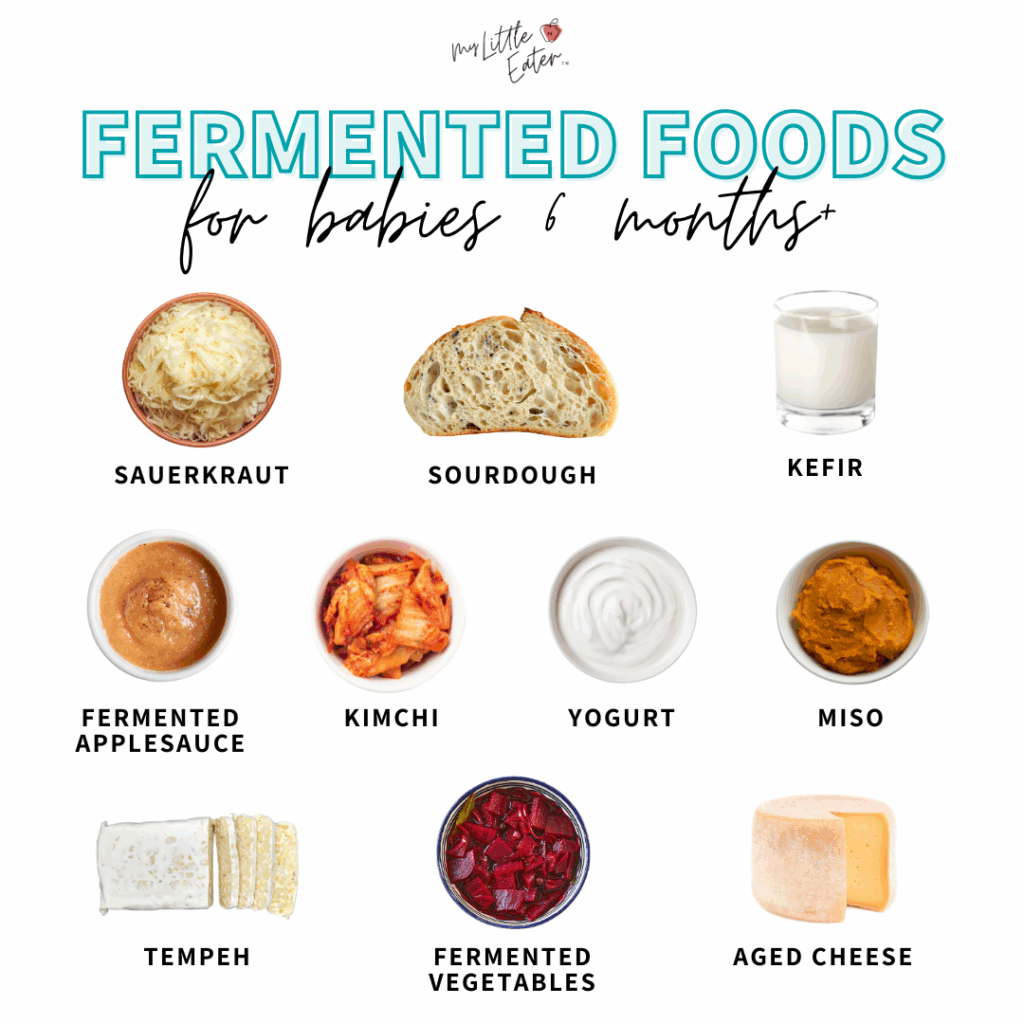
1. Sauerkraut
Sauerkraut is a fermented food that’s made from thinly shredded cabbage. It’s packed with flavor, making it a great food to introduce to your baby to help expand their palate. It’s also a source of nutrients like fiber, vitamin K, and probiotics (2,3).
Sauerkraut is high in sodium, so we recommend rinsing it under cold water before serving it to babies under 12 months of age to reduce the sodium content. Overall, the benefits of introducing a small amount of sauerkraut to your baby outweigh the amount of sodium it contains, especially if you rinse it first.
2. Fermented applesauce
Fermented applesauce is mild, sweet, and tangy! It’s made by fermenting apples with beneficial bacteria, which means it offers probiotics to support your baby’s gut health.
Be sure to choose applesauce that is unsweetened for your baby, as added sugars should be avoided until age 2.
3. Sourdough bread
*Top allergen
True sourdough bread is made with wild yeast and bacteria that ferment the dough over a long period of time. The fermentation process makes the bread easier to digest and can help with nutrient absorption (4).
Another bonus is that sourdough typically lacks all of the added sweeteners and preservatives that other breads can have, so it’s a great option for babies starting at 6 months!
Even though making your own has become extremely popular in recent years, it’s ok if you don’t want to! Store-bought is great to offer your baby as well.
Read more for all the details on how to cut and serve bread according to our signature Texture Timeline™.
4. Kefir
*Top allergen
Kefir is a fermented milk drink that is packed with probiotics. It comes in both dairy and dairy-free versions (dairy-free being made from plant-based milks, like coconut kefir). It has a tart taste and a thin consistency, making it great for adding to smoothies and other recipes in place of milk or buttermilk.
When introducing kefir, choose full-fat (or whole milk), pasteurized, plain, unsweetened versions, and avoid those with added sugar or artificial flavorings.
Keep in mind that dairy-free kefir has less fat than regular kefir because it uses plant-based milk instead of full-fat cow’s milk. However, it still offers beneficial nutrients and probiotics if your baby has an allergy or sensitivity and can’t consume regular kefir!
It’s safe for babies under 1 year of age (but over 6 months of age) to have small amounts of kefir (and any other milk) in recipes. Before your baby turns 1 year old, you’ll want to avoid offering kefir and any milk other than breast milk or formula as a beverage. This includes any animal milk (like goat’s or cow’s milk) and any plant-based milk like almond, oat, soy, etc.
5. Yogurt
*Top allergen
Yogurt is a fermented dairy product that’s rich in protein, calcium, vitamin D, and beneficial bacteria (5). When introducing yogurt to babies, choose full-fat, plain, unsweetened varieties that contain live active cultures.
Plain yogurt can be served on its own or used as a binding puree to make foods with more challenging textures (like rice or quinoa) easier for babies to eat.
Read more for all the details on the best yogurt for babies.
6. Kimchi
Kimchi is a traditional Korean fermented vegetable dish. It is often made from napa cabbage, radishes, and a mix of various spices. It’s packed with beneficial bacteria (probiotics) and has a spicy, tangy flavor (6).
However, some kimchi can be quite spicy for babies, so it’s best to serve it in a milder version without chili peppers or other hot spices. Start with a small portion and chop it finely to ensure it’s safe for your baby.
7. Miso
*Top allergen
Miso is a fermented paste made from soybeans, salt, and fungus, and it is often used in Japanese cuisine as a base for soups and sauces.
While miso is rich in probiotics and essential minerals, it can also be high in sodium (7). Choose low-sodium miso and offer it in small amounts, mixing it into foods like soups, stews, or purées.
8. Tempeh
*Top allergen
Tempeh is made from fermented soybeans and has a firm, cake-like texture. Tempeh is a great protein-rich, fiber-filled food that offers lots of omega-3 fatty acids and B-vitamins (8).
For babies, cook tempeh to soften the texture, then cut it into age-appropriate sizes.
Read more for all the details on how to cut and serve tempeh safely for your baby.
9. Fermented vegetables
Fermented vegetables can include a wide range of foods, from cucumbers and cabbage to carrots, sweet potatoes, and beets. These vegetables are fermented with the help of naturally occurring bacteria, which break down their sugars and create beneficial probiotics (9).
When introducing fermented vegetables to babies, it’s important to ensure that the vegetables are soft and pass the squish test. Sweet potatoes, carrots, and beets are excellent choices for babies that offer beneficial vitamins and minerals and help support digestion and immune health.
Just be mindful of the salt content in store-bought varieties and rinse well before serving them to your baby!
10. Aged cheese
*Top allergen
Some cheeses undergo fermentation, which can be beneficial for gut health, especially when they are aged and contain live cultures (10).
Mild cheeses like cheddar, gouda, parmesan, or Swiss are suitable for babies in small amounts from 6 months and up. Cheese offers an excellent source of protein, calcium, and healthy fats for your baby (10).
Read more for all the details on the best cheese for baby and how to serve it safely.
Did you know?
Some lactose-intolerant individuals can consume fermented dairy products, in particular ripened cheeses such as cheddar.
The reason for this is that during fermentation and cheese ripening, the bacteria break down the lactose (11). This significantly reduces the level of lactose in fermented cheese, often making it tolerable to those with lactose intolerance (11)!
Are there fermented foods that should be avoided or limited?
Yes.
Fermented foods can be made with all sorts of ingredients, as mentioned above, and some are not recommended for babies in their first year of life. Here is a breakdown of which fermented foods we recommend limiting or avoiding.
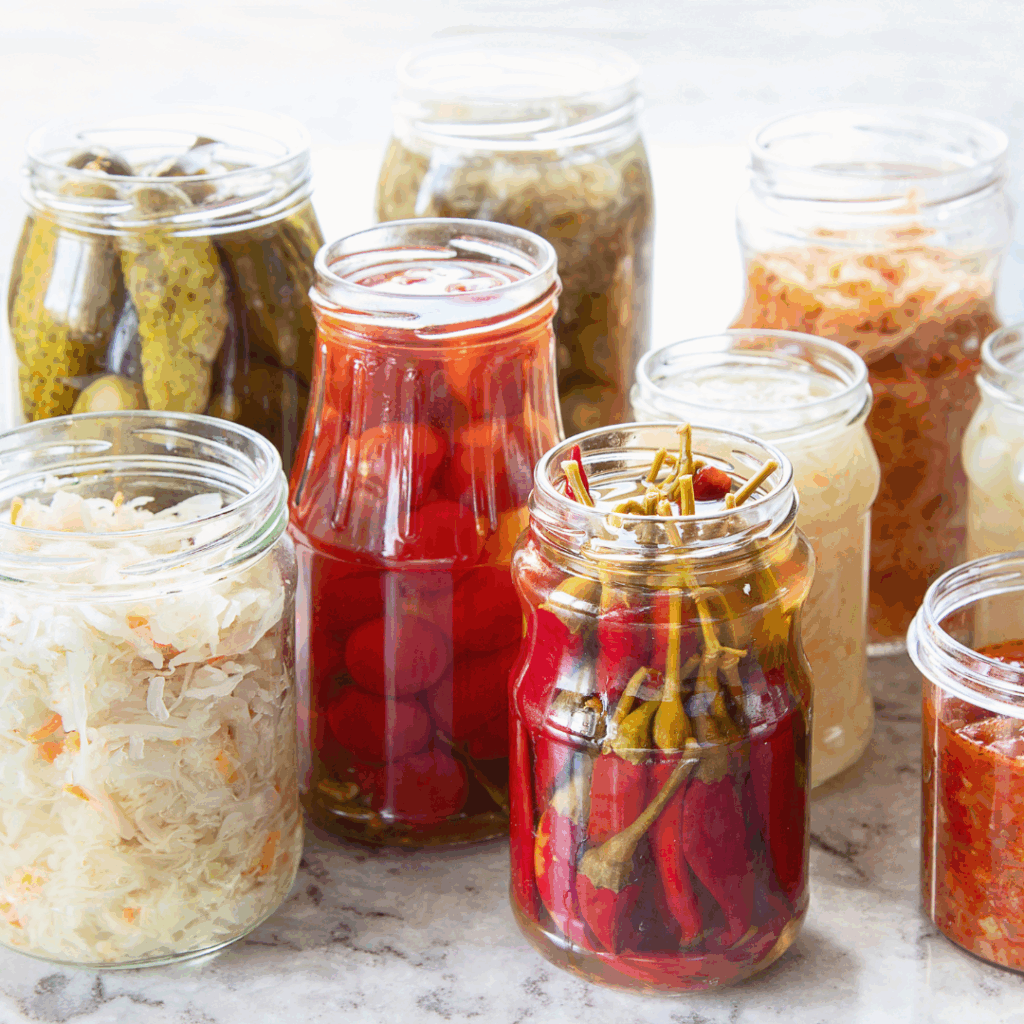
Ferments with excessive salt and/or sugar
While sodium is a required nutrient for your baby’s normal development, you want to avoid offering it in excessive amounts.
But if small amounts of fermented foods are being offered – like 1 tablespoon of sauerkraut or a bit of melted cheese in an omelet – the health benefits and flavor exposure of including them is worth the little bit of extra salt. You can also choose low-sodium versions of fermented foods and/or rinse them before serving to reduce salt content.
The same goes for fermented foods with added sugar. Choose unsweetened versions with no added sugar when possible. As with sodium, the benefits of offering these sweet foods can outweigh the little bit of extra sugar when they’re served in moderation.
fyi
fyi
Rinsing fermented foods may reduce the probiotic content, but the fermented food being offered is still a good source of beneficial bacteria, even when rinsed (12).

Ferments that contain alcohol
Some fermented beverages, like kombucha and water kefir, can contain small amounts of alcohol as a natural byproduct of the fermentation process. The amount of alcohol found in these beverages depends on various factors like fermentation time, yeast strain, and sugar content (13).
Even though these beverages may only contain trace amounts of alcohol, the safest option is to avoid serving them to your baby or toddler.
Honey ferments

Honey fermentation is a process that involves using honey as the primary fermenting agent, typically in combination with other ingredients. The fermentation process occurs when microorganisms (like yeast or beneficial bacteria) break down sugars in the honey, producing different flavors, textures, and beneficial compounds (14).
Honey itself is a naturally antimicrobial substance, which makes it unique for fermentation while still providing an environment that allows fermentation to occur when combined with the right conditions (14).
Honey carries a high risk of a very dangerous illness – botulism – for children younger than one year of age (14).
Infant botulism can cause serious health issues, which is why it’s recommended to avoid all types of honey entirely for the first 12 months of life. This includes pasteurized, unpasteurized, and cooked/processed honey, as any of these versions can still contain the bacteria Clostridium botulinum that can cause infant botulism (14).
After your child’s first birthday, the risk of developing infant botulism is low because they have developed natural defenses against it. These include good bacteria in their intestines to protect against C. botulinum and prevent it from growing and releasing toxins (14).
What are the benefits of offering fermented foods?
The functional microorganisms (aka healthy bacteria) found in fermented foods provide a variety of health-promoting benefits that support your baby’s growth and development (15)!

In general, fermented foods are high in antioxidants, prebiotics, probiotics, and beneficial bacteria that can help to prevent illness (1). They can also help balance hormones, strengthen the immune and digestive systems, and help manage chronic inflammation (1).
Let’s take a closer look at all of the details!
Benefit #1: Immune support & gut health
Our gut houses trillions of microbes, including bacteria, that play a key role in regulating immune function (16). In fact, a significant portion of the body’s immune system resides in the gut, so the probiotics found in fermented foods are essential for immune health (16).
Foods like yogurt, kefir, kimchi, and sauerkraut are probiotic-rich foods that help maintain a balanced gut microbiome (16). This balance is crucial for strong immune responses and the body’s ability to fend off infections (16).
Probiotics in fermented foods also help fortify the intestinal barrier, preventing harmful pathogens from entering the bloodstream (17). Furthermore, some research suggests that fermented foods may stimulate the production of immunoglobulins (antibodies) that help identify and neutralize harmful invaders (18).

Therefore, based on the latest research, regularly consuming fermented foods can have long-lasting positive effects on immune function, making them a valuable addition to a baby’s diet for overall health!
Note: Some fermented foods, such as pickles, are processed after fermentation, which kills the beneficial microorganisms (19). Since live bacteria are responsible for many of the health benefits, foods that no longer contain live microbes do not provide the same probiotic benefits (19).
Benefit #2: Exposure to new flavors
Exposure to a wide variety of foods, flavors, textures, and colors early on in your little one’s feeding journey can influence their food preferences (20, 21).

In other words, early and consistent exposures can help your baby get used to these foods and eventually, maybe even grow to enjoy them (22)!
Sour is an important flavor that is not usually given to babies, except for maybe a taste of lemon here and there to see them make a funny face. Fermented foods are a wonderful way to introduce sour flavors to babies (1).
Benefit #3: Balancing blood sugar
Including fermented foods as part of a balanced diet may also be a helpful strategy for improving insulin sensitivity and regulating blood sugar levels (23).
The probiotics and beneficial bacteria in these foods support gut health, reduce inflammation, and may enhance the body’s ability to process glucose (sugar) effectively. However, more research is needed to fully understand the long-term effects and the most effective types of fermented foods for blood sugar regulation (23).
Due to their known health benefits, researchers have recently proposed that fermented foods be included as part of dietary guidelines (24).
Introducing fermented foods to your baby
With fermented foods, you’ll want to start SLOW with very small amounts so your baby’s system has time to adjust. Start by dipping a spoon into the fermented food of choice and letting your baby have a taste.

If you give too much, too fast, your little one could end up with some digestive discomfort and symptoms that may include gas, bloating, and/or diarrhea.
After a few small introductions, you can then go ahead and offer them as you would other foods. Follow the instructions below for how to serve all fermented foods safely.
My Little Eater
Recommendation
Recommendation
Fermented foods should be served in moderation. A good guideline is to offer them 2–3 times per week, adjusting based on your baby’s tolerance and digestive comfort.
How to serve fermented foods to your baby
There are many different ways to serve fermented foods to your baby. Here are the criteria you’ll want to follow to ensure the fermented foods you’re serving are safe!
Use the “squish test”

An easy way to make sure that a piece of food is soft enough for your baby to eat safely is by doing what we like to call “the squish test”. All you need to do is squish a piece of food between your thumb and index finger using gentle pressure.
If it squishes down easily, that means that your baby will easily be able to mash that food down with the pressure of their gums so that they can chew and eat it safely.
Modify the texture as needed
Fermented foods can be easily modified to minimize choking risk and make the texture less challenging. Some ways to modify the texture and shape include: blending, chopping, mixing it into a purée, or thinly slicing it.
If you have a fermented food that is slippery – you can roll it in a delicious coating like nutritional yeast to give it more grip while also adding an extra boost of nutrition!

If you want to start by puréeing fermented foods instead of going right to finger foods, that’s completely fine too! You can gradually work your way up to more challenging textures at your and your baby’s own pace using our Texture Timeline™.
Modify the shape to minimize the choking risk
Fermented foods can come in a variety of shapes and sizes. When serving them to your baby as a finger food, it’s important to modify them appropriately to minimize this risk.
You can refer to our Texture Timeline™ Food Library (found within our Baby Led Feeding Program) for how to safely serve all foods to your baby.
Below is an example of the videos to expect within the library, along with photos at each phase, nutritional info, allergen info, step-by-step prep and serving instructions, and more!
Risks of offering fermented foods to your baby
While commercially produced fermented foods are generally safe for your baby, there are some potential risks and side effects to keep in mind before you start offering them.
Bloating & gas
Fermented foods may cause temporary bloating or gas in some children, especially when introduced suddenly. Their digestive system might need time to adjust to the new bacteria, and you don’t want to cause your baby discomfort from excessive gas.
As recommended above, start with small amounts and gradually increase serving sizes as your little one adapts.

Although too much too quickly may result in some symptoms, the beneficial bacteria in fermented foods can also help prevent constipation and promote healthy bowel movements, too.
Aka – fermented foods can help your baby poop! Keeping them in your baby’s diet can have beneficial digestive effects once they’re used to them and can easily tolerate them.
Possible contamination
If fermented foods are not prepared or stored with proper sanitation, they can become contaminated with harmful bacteria or mold, leading to foodborne illness. Adults might be able to fight off these germs without much trouble, but babies’ immune systems are still developing, which makes them more vulnerable to infections.
If you’re making your own fermented foods for your baby, be sure to follow proper hygiene and food safety guidelines and store them in clean, airtight containers.
We don’t suggest buying fermented foods from unregulated sources (like farmers’ markets), as there is no way of knowing if the foods were prepared with proper food safety guidelines. Instead, choose fermented foods that are commercially produced as they’re required to follow strict regulations to ensure safety for consumers.

Interaction with medications
Probiotics in fermented foods may interact with certain medications, particularly antibiotics or immune-suppressing drugs, and could either reduce or enhance the effects of these medications (25).
If your child is on any type of medication, it’s always best to consult a healthcare provider before adding fermented foods to their diet.
On the other hand, there is a benefit to offering fermented foods after finishing a round of antibiotics as a way to replenish the good bacteria in the gut that may have been killed off during a course of antibiotics.
In fact, fermented foods can help restore gut health more effectively than taking a probiotic supplement (1).

Sauerkraut Egg Cups for Baby Led Weaning
Equipment
- 1 muffin pan
- Parchment muffin liners
Ingredients
- 1 ½ tsp Extra virgin olive oil
- 5 Eggs (whisked)
- 1 cup Sauerkraut (rinsed and drained)
- 2 tbsp Milk
Instructions
- Preheat the oven to 375ºF (190ºC). Grease a muffin pan with the olive oil or use parchment muffin liners.
- In a bowl, whisk together the eggs, sauerkraut, and milk. Pour the mixture into the muffin pan, almost to the top of each compartment.
- Bake in the oven for 20 to 25 minutes or until the egg cups are golden brown and cooked through. Enjoy!
Video
Notes
Want more recipes to help expose your baby to lots of textures and flavors? Check out our 60 Day Baby Led Feeding Meal Plan – you’ll get access to recipes, grocery lists, expert tips for starting solids, and more!
This isn’t just a regular meal plan with a list of recipes, you’ll actually be able to follow along with the plan to strategically introduce allergens, advance your baby in textures, and ensure all nutrient needs are being met.
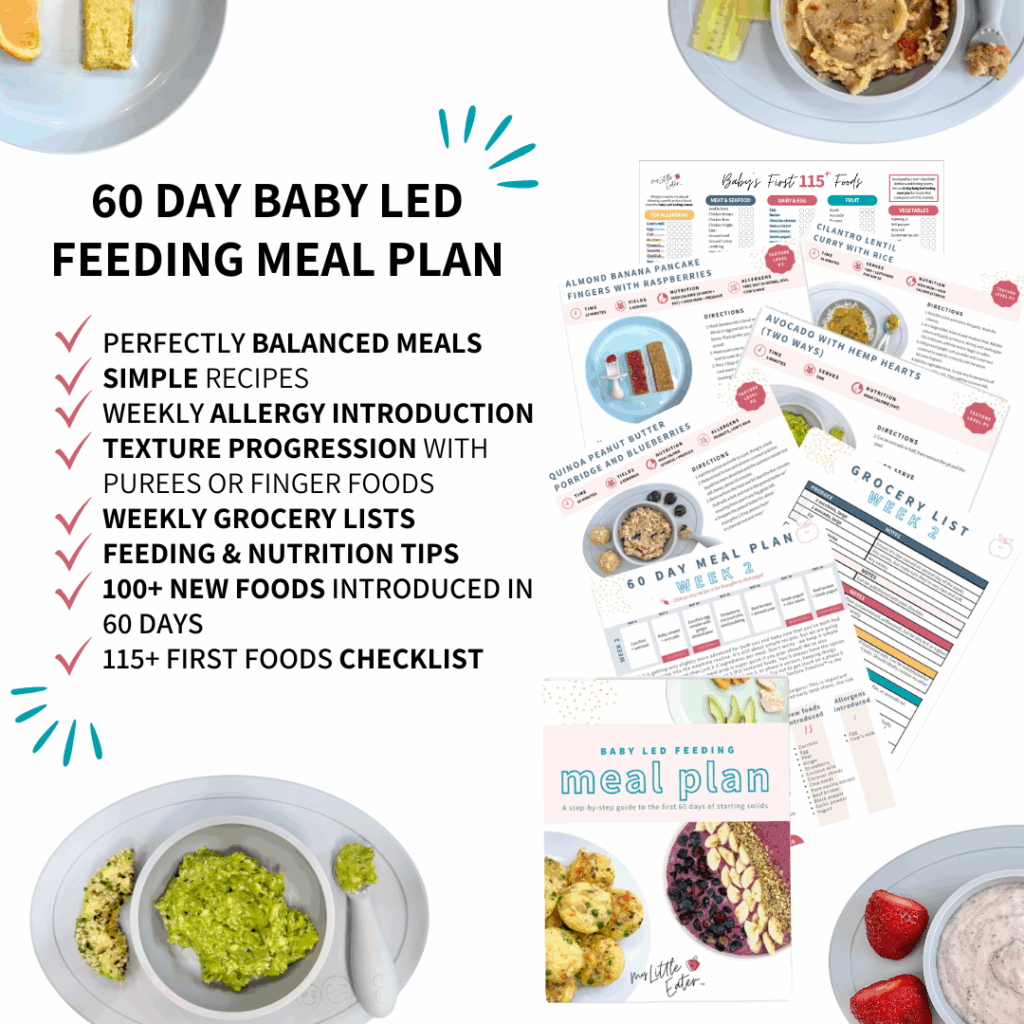
Pin this for later!
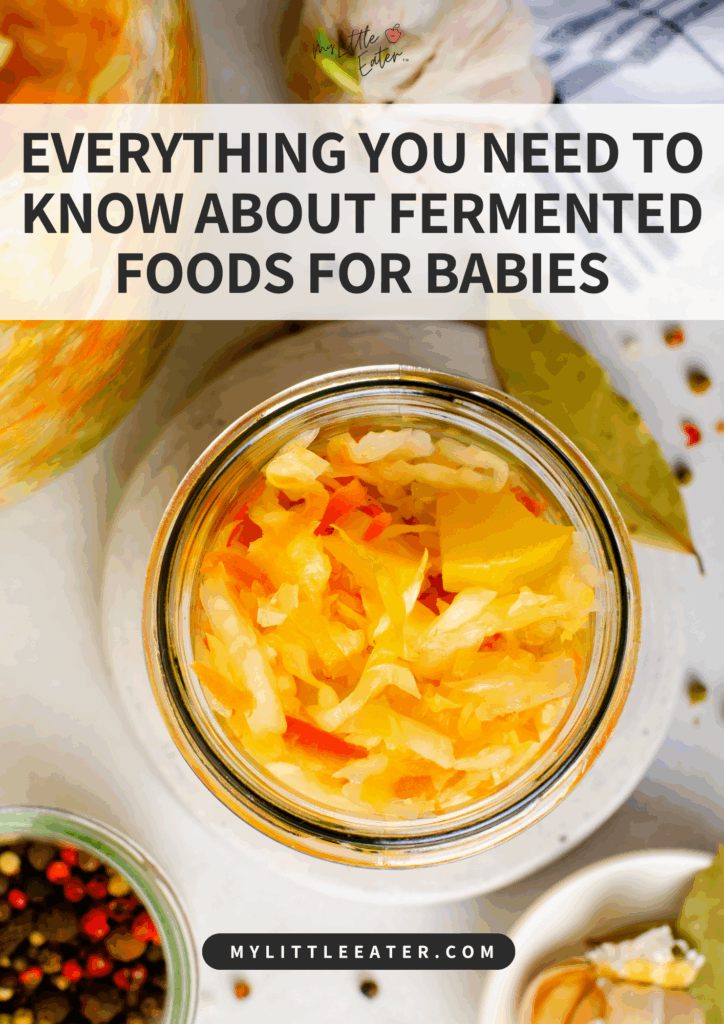
References
- Bell, V., Ferrão, J., & Fernandes, T. (2018). Fermented food guidelines for children. Journal of Pediatrics and Pediatric Medicine, 2(1).
- U.S. Department of Agriculture. (2019). Sauerkraut, canned, solids and liquids. https://fdc.nal.usda.gov/food-details/169279/nutrients
- Marco, M. L., Heeney, D., Binda, S., Cifelli, C. J., Cotter, P. D., Foligné, B., Gänzle, M., Kort, R., Pasin, G., Pihlanto, A., Smid, E. J., & Hutkins, R. (2017). Health benefits of fermented foods: microbiota and beyond. Current opinion in biotechnology, 44, 94–102. https://doi.org/10.1016/j.copbio.2016.11.010
- Rizzello, C. G., Coda, R., & Gobbetti, M. (2017). Use of sourdough fermentation and nonwheat flours for enhancing nutritional and healthy properties of wheat-based foods. In Fermented foods in health and disease prevention (pp. 433-452). Academic Press.
- Savaiano, D. A., & Hutkins, R. W. (2021). Yogurt, cultured fermented milk, and health: a systematic review. Nutrition reviews, 79(5), 599–614. https://doi.org/10.1093/nutrit/nuaa013
- Park, K. Y., Jeong, J. K., Lee, Y. E., & Daily III, J. W. (2014). Health benefits of kimchi (Korean fermented vegetables) as a probiotic food. Journal of medicinal food, 17(1), 6-20.
- Saeed, F., Afzaal, M., Shah, Y. A., Khan, M. H., Hussain, M., Ikram, A., … & Khashroum, A. O. (2022). Miso: a traditional nutritious & health‐endorsing fermented product. Food science & nutrition, 10(12), 4103-4111.
- Rizzo, G. (2024). Soy-based tempeh as a functional food: Evidence for human health and future perspective. Frontiers in Bioscience-Elite, 16(1), 3.
- Szutowska, J. (2020). Functional properties of lactic acid bacteria in fermented fruit and vegetable juices: A systematic literature review. European Food Research and Technology, 246(3), 357-372.
- McCarthy, A. L., O’Connor, T. P., & O’Brien, N. M. Cheese in the context of diet and nutrition. In Handbook of cheese in health: Production, nutrition and medical sciences (pp. 5-8). Wageningen Academic Publishers (2013).
- Leeuwendaal, N. K., Stanton, C., O’toole, P. W., & Beresford, T. P. (2022). Fermented foods, health and the gut microbiome. Nutrients, 14(7), 1527.
- Khan Chand, S. K., & Asfaq, D. S. (2016). Fermented foods and their health benefits. European Journal of Biotechnology and Bioscience. Volume 4; Issue 9, 27-28.
- Marsh, A. J., O’Sullivan, O., Hill, C., Ross, R. P., & Cotter, P. D. (2014). Sequence-based analysis of the bacterial and fungal compositions of multiple kombucha (tea fungus) samples. Food microbiology, 38, 171-178.
- Government of Canada. Infant botulism. Retrieved from: https://www.canada.ca/en/health-canada/services/food-safety-vulnerable-populations/infant-botulism.html
- Skowron, K., Budzyńska, A., Grudlewska-Buda, K., Wiktorczyk-Kapischke, N., Andrzejewska, M., Wałecka-Zacharska, E., & Gospodarek-Komkowska, E. (2022). Two faces of fermented foods—the benefits and threats of its consumption. Frontiers in Microbiology, 13, 845166.
- Round, J. L., & Mazmanian, S. K. (2009). The gut microbiota shapes intestinal immune responses during health and disease. Nature reviews immunology, 9(5), 313-323.
- Yoo, J. Y., Groer, M., Dutra, S. V. O., Sarkar, A., & McSkimming, D. I. (2020). Gut microbiota and immune system interactions. Microorganisms, 8(10), 1587.
- Ansari, F., Neshat, M., Pourjafar, H., Jafari, S. M., Samakkhah, S. A., & Mirzakhani, E. (2023). The role of probiotics and prebiotics in modulating of the gut-brain axis. Frontiers in nutrition, 10, 1173660.
- National Institutes of Health. Probiotics Fact Sheet for Consumers. Retrieved from: https://ods.od.nih.gov/pdf/factsheets/Probiotics-Consumer.pdf
- Mennella J. A. (2014). Ontogeny of taste preferences: basic biology and implications for health. The American journal of clinical nutrition, 99(3), 704S–11S.https://doi.org/10.3945/ajcn.113.067694
- Trabulsi, J. C., & Mennella, J. A. (2012). Diet, sensitive periods in flavour learning, and growth. International review of psychiatry (Abingdon, England), 24(3), 219–230.https://doi.org/10.3109/09540261.2012.675573
- Spill, M. K., Johns, K., Callahan, E. H., Shapiro, M. J., Wong, Y. P., Benjamin-Neelon, S. E., Birch, L., Black, M. M., Cook, J. T., Faith, M. S., Mennella, J. A., & Casavale, K. O. (2019). Repeated exposure to food and food acceptability in infants and toddlers: a systematic review. The American journal of clinical nutrition, 109(Suppl_7), 978S–989S. https://doi.org/10.1093/ajcn/nqy308
- Viguiliouk, E., Khan, T. A., & Nettleton, J. E. (2009). Probiotics and blood glucose control: A review. Diabetes Care, 32(12), 2280-2289. https://doi.org/10.2337/dc09-1485
- Leeuwendaal, N. K., Stanton, C., O’toole, P. W., & Beresford, T. P. (2022). Fermented foods, health and the gut microbiome. Nutrients, 14(7), 1527.
- Mazziotta, C., Tognon, M., Martini, F., Torreggiani, E., & Rotondo, J. C. (2023). Probiotics mechanism of action on immune cells and beneficial effects on human health. Cells, 12(1), 184.

Chelsey Landry, RD
Community Dietitian at My Little Eater Inc., and bunny-mom to Hickory. Chelsey offers one-on-one counselling to parents of babies and toddlers that need more customized support. Learn more by booking a free discovery call with her today!

Chelsey Landry, RD
Community Dietitian at My Little Eater Inc., and bunny-mom to Hickory. Chelsey offers one-on-one counselling to parents of babies and toddlers that need more customized support. Learn more by booking a free discovery call with her today!





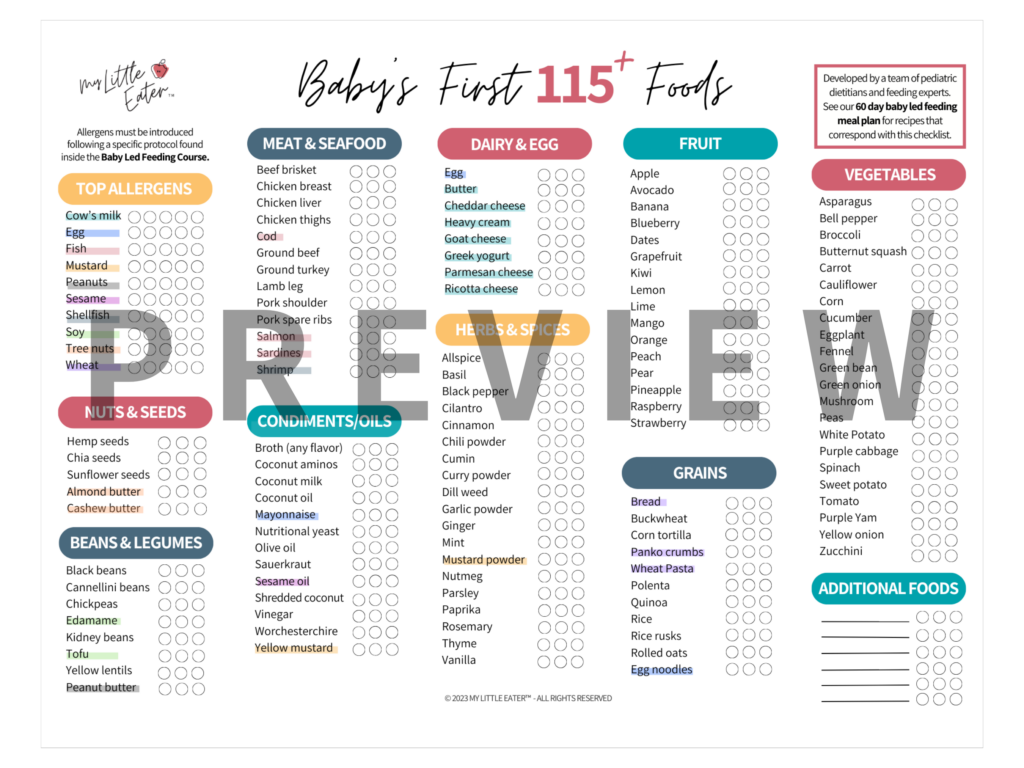
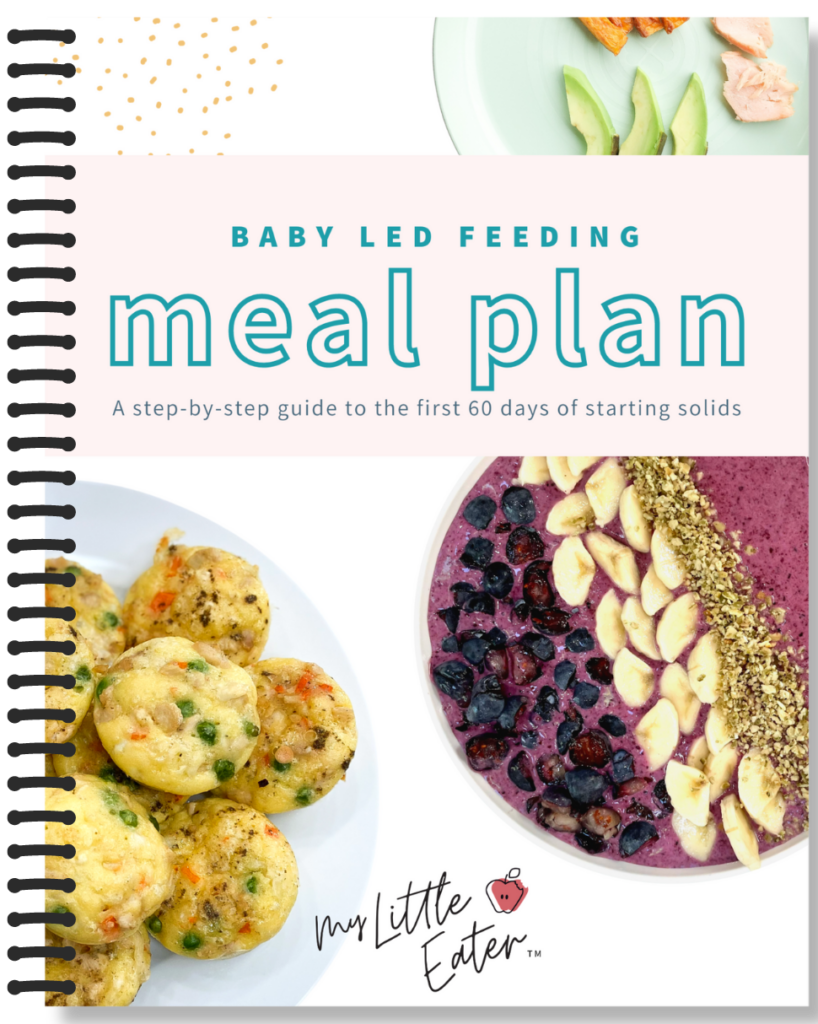


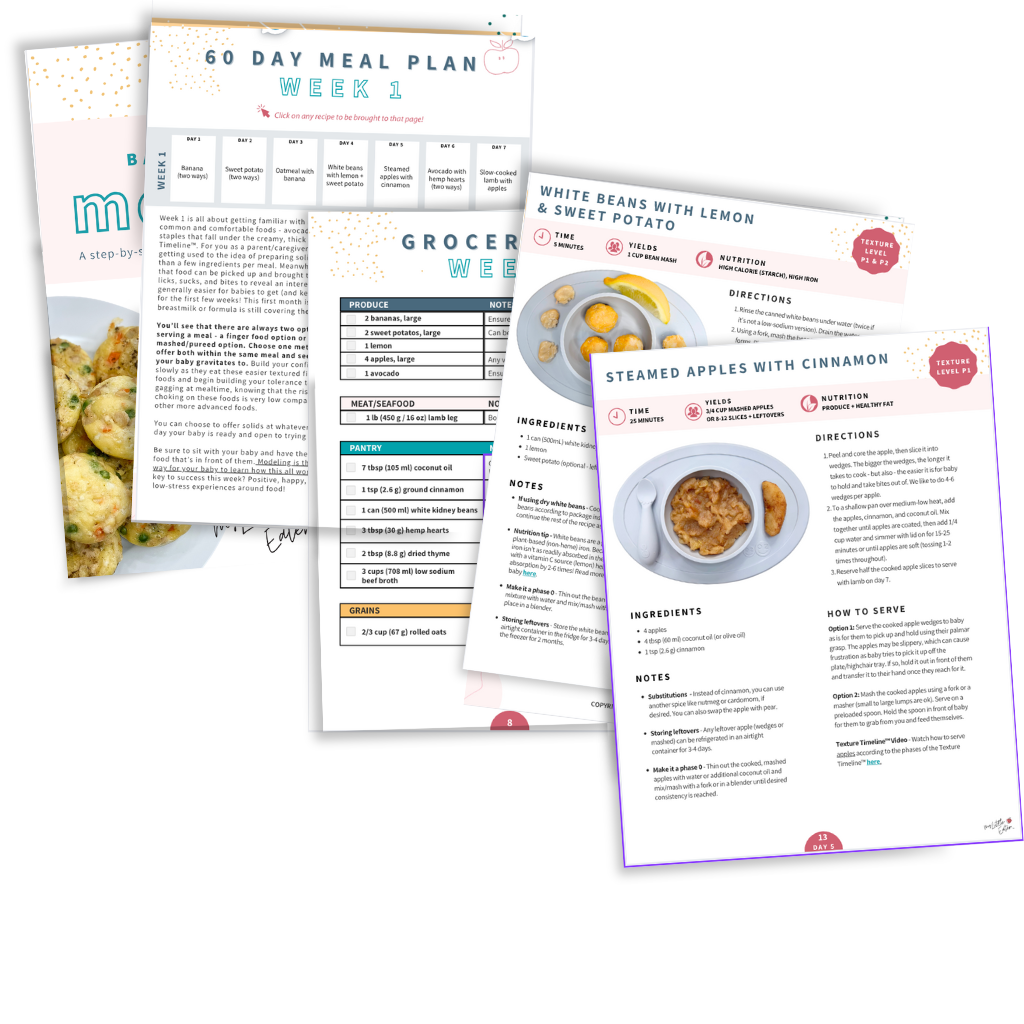
3 Comments
Thank you for sharing this guide! We should start giving our children healthy food as early as possible so they will develop a love for and choose foods that are good for their health, rather than unhealthy ones.
We’re so glad to hear you found this blog helpful!
Do you have recipes to make your own fermented foods for baby?